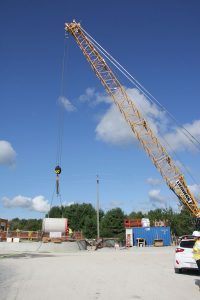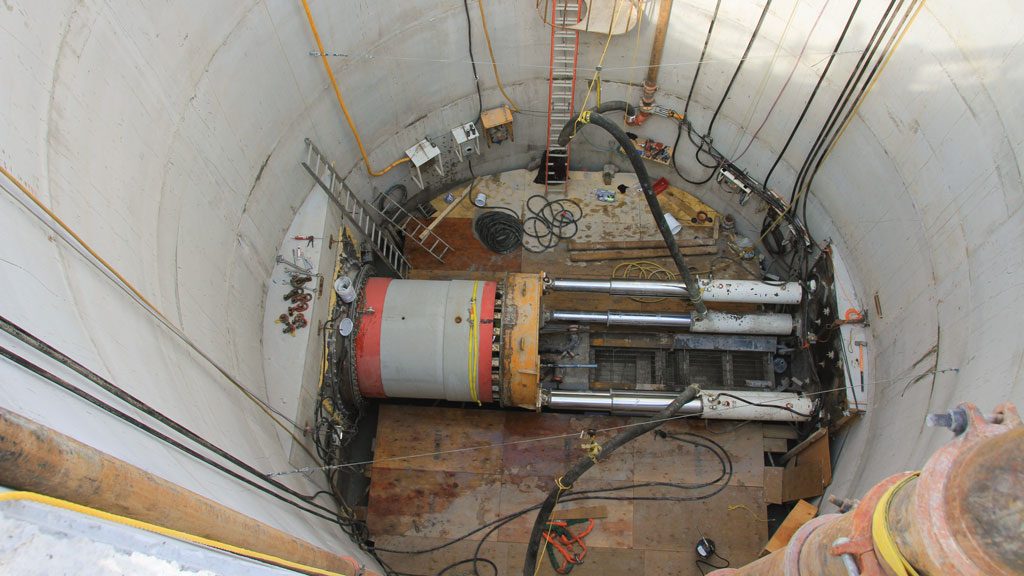A large, yellow crawler crane is in position, poised over a concrete shaft at the pie-shaped worksite near Fairy Lake in Newmarket, Ont. Nearby, an excavator operator is loading dirt onto a waiting dump truck.
Nothing out of the ordinary for your typical construction site, really.
Roughly 12 metres below ground, though, it’s a different story. A cigar-shaped, micro-tunnel boring machine is ready to go to work.
The task?
Dig away at the dense underground soil and dirt so concrete pipes can be laid for a 5.1-kilometre-long sewage pipe that will run parallel to an existing 36-year-old forcemain through the heart of Newmarket.
Work on the $110.6-million project, aptly named the York Durham Sewage System Forcemain Twinning Project, is well under way and should be completed by December 2021. The project also includes changes to the Newmarket and Bogart Creek sewage pumping stations to improve the system.

The machine, one of two presently being used on the project, will tunnel west towards Cane Parkway. A second machine will tunnel north from another work area along the route to Newmarket Pumping Station.
The machines will create a tunnel about two metres in diameter. They are pushed by a hydraulic jack and concrete tubes are placed behind.
“At the moment, we’re completing our fifth tunnel drive,” explains Jose Manalo, project manager, capital planning and delivery, environmental services, for Newmarket. “We’re micro-tunnelling the pipe across Newmarket from the north end to the south end.
“Micro-tunnelling is a type of technology where we can do installation of pipe and don’t have to open-cut the road and disturb river crossings and whatnot. In total, we have seven micro-tunnel drives. We completed four to date and we are about two weeks away from completing our fifth out of seven drives.”
The project involves twinning the town’s existing forcemain, which will move wastewater from the Newmarket Pumping Station to the Aurora Pumping Station, along with installing 530 metres of pressurized pipe to move wastewater from the Bogart Creek Pumping Station to the new forcemain. Changes will also be made to the Newmarket and Bogart Creek Stations to connect to the new forcemain.
The current forcemain was built around 1983. Presently, Newmarket is the only municipality in the region without a twin forcemain. The plan is to transfer sewage flow to the new pipe and maintain the old one.
The new forcemain will run under 11 river crossings and three railways crossings and below parks and major streets.
“It cuts across very dense urban area in Newmarket and we have seven, strategically-placed work areas. Within those work areas we drive the tunnel from point A to point B,” says Manalo.
“Right now, we have two machines that are tunnelling in different directions to ensure we finish the project on schedule.”
The boring machines are smaller and different than the much larger tunnel-boring machines (TBMs) used on projects like the Metrolinx Eglinton Crosstown light rail line in Toronto. The TBMs are run by an operator inside the machines, whereas the micro-tunnel boring machines are run by an operator above ground.
The micro-tunnel boring machines churn away at the ground and a crane then lowers segments of pipe as it is pushed forward.
It takes a small team of 18 to 20 workers to ensure that the placement and alignment of the machine is correct and that it stays on track.
Contractor for the tunnelling work is Ward & Burke Construction. The company has completed several similar projects in Ontario, including the Burbrook Trunk Sewer Project, a $9.5-million project that involved constructing concrete caissons and two micro-tunnels under rail lines in London, Ont.
As with any tunnel-boring project, the biggest challenge is the soil conditions. The operator adapts as the machine moves along.

“We do our best to try to determine the makeup and the science of the soil conditions so that we can prepare ourselves for what we have to deal with,” says Manalo.
“However, you don’t always know exactly what soil conditions you’re faced with. The main operator needs to be skilled in order to overcome this.”
When the machine is boring, the operator is constantly looking at data that is sent back and adjusts the speed and torque of the machine accordingly. Noise is a factor, but engineers have designed the project so that work areas are enclosed as much as possible.
“We’ve insulated all of our sound-generating equipment,” explains Manalo.
“We’ve housed them off and put insulation blankets around them just to let the vibration and noise from the equipment dissipate.”
Original plans called for the forcemain to be installed using an open-cut method, but the amount of trenching required would have been very disruptive to the community and businesses, so the town opted to go with micro-tunnelling in order to ensure less disturbance and to protect the environment.
The machines are incredibly accurate, notes Manalo, and use a laser-guided system so the operator always knows their precise location.
“When they do a breakthrough, they’ll draw a circle around where they want it to come through and it’s just amazing. The combination of a laser-guided system and surveying always ensures that they meet the target.”





Recent Comments
comments for this post are closed